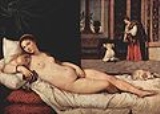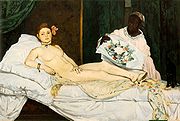
Venus of Urbino
Encyclopedia
The Venus of Urbino is a 1538 oil painting by the Italian master Titian
. It depicts a nude young woman, identified with the goddess Venus
, reclining on a couch or bed in the sumptuous surroundings of a Renaissance
palace. It hangs in the Galleria degli Uffizi in Florence
. The figure's pose is based on Giorgione
's Sleeping Venus
(c. 1510), which Titian completed. In this depiction, Titian has domesticated Venus by moving her to an indoor setting, engaging her with the viewer, and making her sensuality explicit. Devoid as it is of any classical or allegorical trappings -Venus displays none of the attributes of the goddess she is supposed to represent- the painting is unapologetically erotic.
The frankness of Venus's expression is often noted; she stares straight at the viewer, unconcerned with her nudity
. In her right hand she holds a posy of roses whilst her left covers her vulva
(she seems to toy with a strand of pubic hair
), which is provocatively placed in the center of the composition. In the near background is a dog, often a symbol of fidelity
.
The painting was commissioned by Guidobaldo II della Rovere
, the Duke of Urbino, possibly to celebrate his 1534 marriage. It would originally have decorated a cassone
, a chest traditionally given in Italy as a wedding present. The maids in the background are shown rummaging through a similar chest, apparently in search of Venus's clothes. Curiously, given its overtly erotic content, the painting was intended as an instructive "model" for Giulia Varano, the Duke's extremely young bride. The argument for the painting's didacticism was made by the late art historian Rona Goffen in 1997's “Sex, Space, and Social History in Titian’s Venus of Urbino". Titian contrasts the straight lines of the architecture with the curves of the female form, and the screen behind Venus bisects the painting, a large-scale division that is mitigated by unifying elements such as the use of colour and the floral patterns of the couch, cassoni, and background tapestries.
The argument for the painting's didacticism was made by the late art historian Rona Goffen in 1997's “Sex, Space, and Social History in Titian’s Venus of Urbino". Titian contrasts the straight lines of the architecture with the curves of the female form, and the screen behind Venus bisects the painting, a large-scale division that is mitigated by unifying elements such as the use of colour and the floral patterns of the couch, cassoni, and background tapestries.
In his 1880 travelogue
A Tramp Abroad
, Mark Twain
called the Venus of Urbino "the foulest, the vilest, the obscenest picture the world possesses". He proposed that "it was painted for a bagnio
, and it was probably refused because it was a trifle too strong", adding humorously that "in truth, it is a trifle too strong for any place but a public art gallery".
Venus of Urbino inspired Édouard Manet
's 1863 Olympia
in which the figure of Venus is replaced with the model Victorine Meurent
.
Titian
Tiziano Vecelli or Tiziano Vecellio Tiziano Vecelli or Tiziano Vecellio Tiziano Vecelli or Tiziano Vecellio (c. 1488/1490 – 27 August 1576 better known as Titian was an Italian painter, the most important member of the 16th-century Venetian school. He was born in Pieve di Cadore, near...
. It depicts a nude young woman, identified with the goddess Venus
Venus (mythology)
Venus is a Roman goddess principally associated with love, beauty, sex,sexual seduction and fertility, who played a key role in many Roman religious festivals and myths...
, reclining on a couch or bed in the sumptuous surroundings of a Renaissance
Renaissance
The Renaissance was a cultural movement that spanned roughly the 14th to the 17th century, beginning in Italy in the Late Middle Ages and later spreading to the rest of Europe. The term is also used more loosely to refer to the historical era, but since the changes of the Renaissance were not...
palace. It hangs in the Galleria degli Uffizi in Florence
Florence
Florence is the capital city of the Italian region of Tuscany and of the province of Florence. It is the most populous city in Tuscany, with approximately 370,000 inhabitants, expanding to over 1.5 million in the metropolitan area....
. The figure's pose is based on Giorgione
Giorgione
Giorgione was a Venetian painter of the High Renaissance in Venice, whose career was cut off by his death at a little over thirty. Giorgione is known for the elusive poetic quality of his work, though only about six surviving paintings are acknowledged for certain to be his work...
's Sleeping Venus
Sleeping Venus (Giorgione)
The Sleeping Venus, also known as the Dresden Venus, is a painting by the Italian Renaissance master Giorgione, with, it is now generally accepted, the landscape and sky, by Titian, completed after Giorgione's death in 1510, as Vasari first noted...
(c. 1510), which Titian completed. In this depiction, Titian has domesticated Venus by moving her to an indoor setting, engaging her with the viewer, and making her sensuality explicit. Devoid as it is of any classical or allegorical trappings -Venus displays none of the attributes of the goddess she is supposed to represent- the painting is unapologetically erotic.
The frankness of Venus's expression is often noted; she stares straight at the viewer, unconcerned with her nudity
Nudity
Nudity is the state of wearing no clothing. The wearing of clothing is exclusively a human characteristic. The amount of clothing worn depends on functional considerations and social considerations...
. In her right hand she holds a posy of roses whilst her left covers her vulva
Vulva
The vulva consists of the external genital organs of the female mammal. This article deals with the vulva of the human being, although the structures are similar for other mammals....
(she seems to toy with a strand of pubic hair
Pubic hair
Pubic hair is hair in the frontal genital area, the crotch, and sometimes at the top of the inside of the legs; these areas form the pubic region....
), which is provocatively placed in the center of the composition. In the near background is a dog, often a symbol of fidelity
Fidelity
"Fidelity" is the quality of being faithful or loyal. Its original meaning regarded duty to a lord or a king, in a broader sense than the related concept of fealty. Both derive from the Latin word fidēlis, meaning "faithful or loyal"....
.
The painting was commissioned by Guidobaldo II della Rovere
Guidobaldo II della Rovere
Guidobaldo II della Rovere was an Italian condottiero, who was Duke of Urbino from 1538 until his death.- Biography :...
, the Duke of Urbino, possibly to celebrate his 1534 marriage. It would originally have decorated a cassone
Cassone
Among furniture in Italy, a cassone or marriage chest is a rich and showy type of chest, which may be inlaid or carved, prepared with gesso ground then painted and gilded. The cassone was one of the trophy furnishings of rich merchants and aristocrats in Italian culture, from the Late Middle Ages...
, a chest traditionally given in Italy as a wedding present. The maids in the background are shown rummaging through a similar chest, apparently in search of Venus's clothes. Curiously, given its overtly erotic content, the painting was intended as an instructive "model" for Giulia Varano, the Duke's extremely young bride.

In his 1880 travelogue
Travel literature
Travel literature is travel writing of literary value. Travel literature typically records the experiences of an author touring a place for the pleasure of travel. An individual work is sometimes called a travelogue or itinerary. Travel literature may be cross-cultural or transnational in focus, or...
A Tramp Abroad
A Tramp Abroad
A Tramp Abroad is a work of non-fiction travel literature by American author Mark Twain, published in 1880. The book details a journey by the author, with his friend Harris , through central and southern Europe...
, Mark Twain
Mark Twain
Samuel Langhorne Clemens , better known by his pen name Mark Twain, was an American author and humorist...
called the Venus of Urbino "the foulest, the vilest, the obscenest picture the world possesses". He proposed that "it was painted for a bagnio
Bagnio
A Bagnio was originally a bath or bath-house.The term was then used to name the prison for hostages in Istanbul, which was near the bath-house, and thereafter all the slave prisons in the Ottoman Empire and the Barbary regencies...
, and it was probably refused because it was a trifle too strong", adding humorously that "in truth, it is a trifle too strong for any place but a public art gallery".
Venus of Urbino inspired Édouard Manet
Édouard Manet
Édouard Manet was a French painter. One of the first 19th-century artists to approach modern-life subjects, he was a pivotal figure in the transition from Realism to Impressionism....
's 1863 Olympia
Olympia (painting)
Olympia is an oil on canvas painting by Édouard Manet. Painted in 1863, it measures 130.5 by 190 centimetres . The nation of France acquired the painting in 1890 with a public subscription organized by Claude Monet...
in which the figure of Venus is replaced with the model Victorine Meurent
Victorine Meurent
Victorine Louise Meurent was a French painter and a famous model for painters.Although she is now best known as the favourite model of Édouard Manet, she also was an artist in her own right, who exhibited repeatedly at the prestigious Paris Salon...
.
External links
- Titian's Venus of Urbino - critical review of the painting

